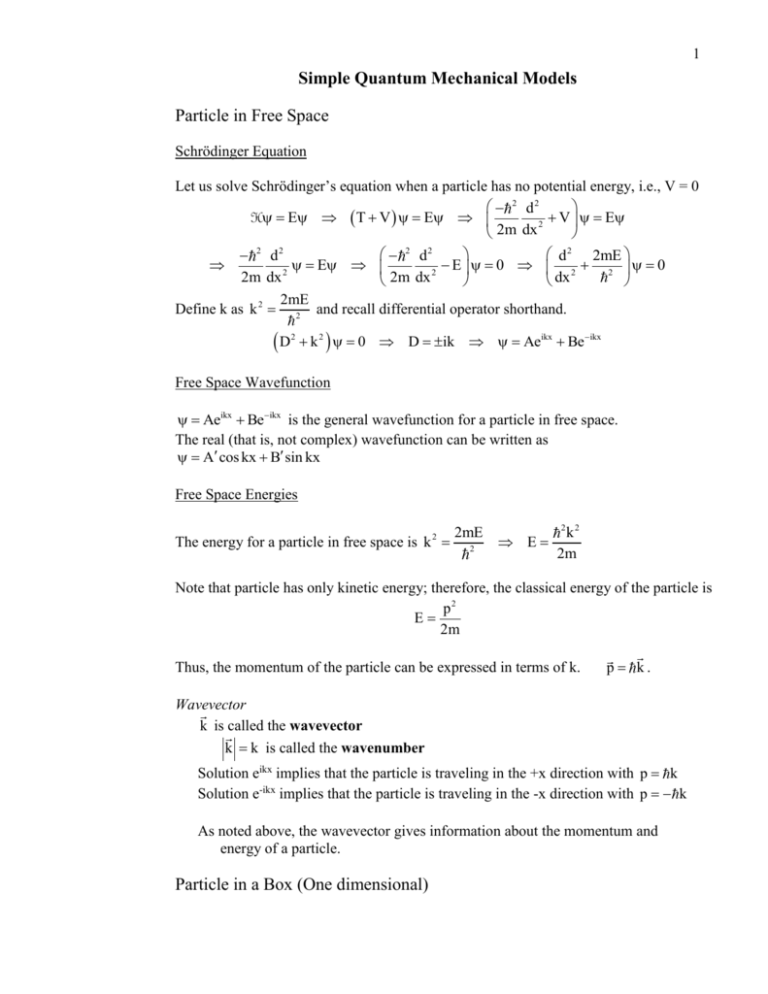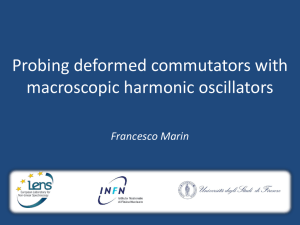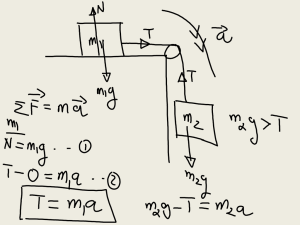doc
advertisement

1 Simple Quantum Mechanical Models Particle in Free Space Schrödinger Equation Let us solve Schrödinger’s equation when a particle has no potential energy, i.e., V = 0 2 d2 H E T V E V E 2 2m dx 2 d2 d 2 2mE 2 d2 E E 0 2 2 0 2 2m dx 2 2m dx dx 2mE Define k as k 2 2 and recall differential operator shorthand. D 2 k 2 0 D ik Aeikx Be ikx Free Space Wavefunction Aeikx Beikx is the general wavefunction for a particle in free space. The real (that is, not complex) wavefunction can be written as A cos kx B sin kx Free Space Energies The energy for a particle in free space is k 2 2mE 2 E 2 k2 2m Note that particle has only kinetic energy; therefore, the classical energy of the particle is p2 E 2m Thus, the momentum of the particle can be expressed in terms of k. p k. Wavevector k is called the wavevector k k is called the wavenumber Solution eikx implies that the particle is traveling in the +x direction with p k Solution e-ikx implies that the particle is traveling in the -x direction with p k As noted above, the wavevector gives information about the momentum and energy of a particle. Particle in a Box (One dimensional) 2 One-dimensional particle-in-a-box wavefunction 0 0 x L Potential Energy Function: V x x 0 or x L Inside the box, the particle has no potential energy; therefore, the wavefunction is the free particle wavefunction, I x Aeikx Beikx or II I II L I x A cos kx B sin kx Outside the box, II x 0 , since the particle would have infinite energy if it were outside the box. It is a physical impossibility for a particle to have infinite energy; therefore, the particle has zero probability of being outside the box. Application of boundary conditions We have two different wavefunctions depending on the value of the position, x. However, one of the requirements of the wavefunction is that it must be continuous for all x. In other words, I 0 II 0 and I L II L . Therefore, at the edges of the box, I x must be zero. These requirements are known as boundary conditions. I 0 II 0 I 0 A cos k0 B sin k0 0 A 0 I x B sin kx I L II L I L B sin kL 0 kL n k Thus, I x A sin n L nx (I have arbitrarily renamed B′ as A since B′ is only a label.) L 3 Normalization of particle-in-a-box wavefunction The probability that the wavefunction be somewhere in the box must be one, therefore, we must normalize the wavefunction. * I x I x d 1 L A sin 0 nx nx nx A sin dx A 2 sin 2 dx 1 L L L 0 L 1 1 nx 1 1 2nx sin 2 cos 2 sin 2 cos 2 2 L 2 2 L L L n x 1 1 2n x x 1 2 nx L 2 A 2 sin 2 dx A 2 cos dx A sin 0 n L 2 2 L 2 L 0 0 4 L L L L 2nL 0 2n0 2 L 2 L A2 sin sin 1 A 0 0 0 A 2 L 2 4n L 2 2 4n 2 2 A2 A L L 2 nx Thus the normalized wavefunction for a particle-in-a-box is I x sin L L Particle-in-a-box Energies The energies for a particle-in-a-box are given as 2 k2 n n 2 2 2 n and k E where n 1, 2,3,... 2m L 2m L 2mL2 Note n cannot be zero since the particle must be somewhere. n 0 0 E 2 2 Note that allowed energies are quantized. - Boundary conditions cause quantization of energy. - **Any particle bound within a potential will have quantized energies.** - The lowest possible energy is not zero, that is, particle is still moving at lowest possible energy. - Lowest possible energy is zero-point energy. - A nonzero zero-point energy is a strictly quantum mechanical effect. - Classically, zero-point energy is always zero. 4 Tunneling Classically, when a particle has less energy than a finite potential energy, the particle cannot overcome potential energy. (I.e., to clear a wall, a particle must have higher kinetic energy than the potential energy of the wall height.) Strangely, a quantum mechanical particle with less kinetic energy than a finite potential energy can overcome potential energy to enter into the ‘classically forbidden region’ (CFR) - I.e., A quantum mechanical particle can go through walls!!??!! The entering of the particle into the CFR is known as tunneling. Note that when the particle is in the CFR, E<V(x) - Since E = T+V, E<V(x) implies that T < 0 - Thinking of the particle classically leads to counterintuitive results. The potential energy function shown is called the step potential. tunneling As the energy of the particle comes closer to the potential energy, the probability for tunneling increases. Consider wavefunction in classically forbidden region. 2 d2 d 2 2m V E 2 V E 0 2m dx 2 dx 2 2m V E k CFR CFR x Ae kCFR x 2 The larger V – E, the less the particle tunnels into CFR. Note that if E > V, that V – E is negative and the wavenumber becomes imaginary and the wavefunction becomes sinusoidal. Now consider barrier potential or “double well potential” 5 As stated above, when the energy of the particle comes closer to the potential energy of the barrier, the probability for tunneling increases. Higher probability of tunneling. - Particle is able to completely penetrate barrier. Lower probability of tunneling. - Particle cannot penetrate barrier. - Particle is in left box or right box. Applications of Tunneling Inversion of ammonia H H H N N HH N HH H H Lone pair must tunnel through nitrogen nucleus. The inversion rate at room temperature is approximately 2 1011 Hz. Proton transfer reactions O H H C C H O O H HH The speed with which a proton is transferred from acid to base can only be explained with relatively low-energy transition states. These low-energy transition states involve tunneling of the proton from the covalent bond with the acid to the covalent bond of the protonated base. Alpha decay of nuclei Alpha particle is trying to overcome strong nuclear force Alpha particle no longer experiences strong nuclear force. Now electric repulsion predominates 6 Particle in a Box (Two dimensional) Schrödinger Equation 0 0 x L, 0 y L Potential Energy Function: V x, y otherwise Schrödinger Equation 2 d2 d2 x, y E x, y 2m dx 2 dy2 - Each degree of freedom (coordinate) has kinetic energy. Use technique of separation of variables to solve. 1.) Assume solution is product of single variable functions x, y X x Y y 2.) Substitute solution into Schrödinger equation 2 d2 d2 X x Y y EX x Y y 2m dx 2 dy 2 d2 d2 2mE X x Y y 2 X x Y y 0 2 2 dx dy d2 2mE d2 2 2 2 X x Y y X x Y y 0 where k 2 dx dy Allow the differential operators to operate d2X x d 2Y y Y y X x X x Y y 0 dx 2 dy 2 3.) Divide equation by the assumed solution d2X x d2Y y 1 Y y X x X x Y y 0 2 2 X x Y y dx dy 2 2 1 d Xx 1 d Y y 0 X x dx 2 Y y dy 2 Let x y since the coordinates are independent from each other, thus the kinetic energies should be independent. 2 2 1 d Xx 1 d Y y x y 0 X x dx 2 Y y dy 2 2 1 d Xx x 0 X x dx 2 d2X x x X x 0 Therefore, dx 2 and 2 1 d Y y y 0 Y y dy 2 and d2Y y yY y 0 dy 2 7 Two-dimensional particle-in-a-box wavefunction n y 2 n x 2 and Y y sin x sin y L L L L n y 2 n x Therefore x, y X x Y y sin x sin y L L L The wavefunctions are X x The energies for the two-dimensional particle-in-a-box are 2 2 2 n 2 2 2 n n x ,n y x, y E E x E y x 2 y 2 2mL 2mL Degenerate Wavefunctions Degeneracy – condition where two states have same energy. The two-dimensional particle-in-a-box have degenerate energy states 2 2 2 E n x ,n y n n 2y 2 x 2mL Consider the energy of the state where nx = 1 and ny = 2, 1,2 x, y E1,2 2 2 2 52 2 2 1 2 2mL2 2mL2 Compare to the energy of the state where nx = 2 and ny = 1, 2,1 x, y E 2,1 2 2 2 2 52 2 2 1 2mL2 2mL2 Thus 1,2 x, y and 2,1 x, y are degenerate states. 8 nx = 1, ny = 1 nx = 2, ny = 1 nx = 1, ny = 2 M N P nx = 2, ny = 2 nx = 3, ny = 2 nx = 2, ny = 5 R R R Degeneracy is consequence of the symmetry of the system. Decreasing the symmetry “lifts” the degeneracy. Consider the energies of a particle in a 2-d rectangular box. 2 2 2 n 2x 2 2 n y E n x ,n y 2mL2x 2mL2y Now, since Lx Ly; E1,2 E2,1 Different lengths of the box causes different energies. Lx Ly 9 Harmonic Oscillator Classical Review Recall’s Hooke’s Law F k x x 0 x0 = length of spring at equilibrium k = force constant Set x0 = 0 What is potential energy function for harmonic oscillator? Recall relationship between force and potential energy. V Fx x Use relationship to find potential energy of harmonic oscillator. Fx V x 1 V Fx dx kx dx kx 2 2 Schrödinger Equation 2 d2 1 2 kx E 2 2m dx 2 2 2 d mk 2 2 2 x E 2m dx At this point, a new variable, sometimes called the dimensionless position, (xi, say zee) is defined, strictly for convenience. 1 mk 4 2 x Caution! k is force constant not wavevector. After substituting the dimensionless position the Schrödinger equation for the harmonic oscillator becomes. d 2 2 d2 2mE 2 mk 2E m 2E k 2 d 2 2E 2 0 d2 Recall k m 10 Harmonic Oscillator Wavefunction This differential equation is solved using a polynomial series. We will not derive the wavefunctions explicitly; instead, we will state the wavefunction without proof. N H e - vibrational quantum number N = normalization constant e polynomials 2 2 2 2 = 0, 1, 2, 3, … = Gaussian function H = Hermite Hermite Polynomials H0 1 Harmonic oscillator wavefunctions form an orthogonal basis set. H1 2 H2 42 2 H3 83 12 H4 16 48 12 4 2 N H e 2 2 N H e 2 2 d , Generating function Any Hermite polynomial can be found using the following generating function. 2 d 2 H 1 e e d Recursion relations The Hermite polynomials can be related to each other with the following relationships. 1 H H 1 H 1 2 dH 2H H1 d Using these relationships can greatly simplify calculations with harmonic oscillator wavefunctions. An example with a recursion relation. 1 H3 H 2 H 4 2 1 83 12 3 4 2 2 16 4 48 2 12 2 4 2 2 8 12 12 6 8 4 24 2 6 84 122 84 122 242 6 6 84 122 84 122 11 Note that the Hermite polynomials are unbounded. Thus, the Gaussian envelope ensures that the harmonic oscillator wavefunctions are finite. Energy Levels of the Harmonic Oscillator 1 E 2 Note that the harmonic oscillator has a nonzero zero-point energy. 1 E0 2 Also note that the energy levels are evenly spaced. Orthonormality of Harmonic Oscillator Wavefunctions d N H e 2 2 N H e 2 2 d , **Keep in mind that the orthonormality of the basis set can often save a great deal of tedious integration work.** Example: Calculate the expectation value of the potential energy for the harmonic oscillator in the arbitrary state, . ˆ 1 kx 2 V 2 ˆ V 1 2 kx d 2 1 1 2 2 2 mk 4 Recall that 2 x x 2 mk 1 1 k 2 2 1 2 2 2 V̂ k d d 2 mk 4m Make substitution for using the recursion relation, 1 H H 1 H 1 2 e 2 2 1 1 H H 1 2 H 1 1 2 1 Note also that k m 12 1 22 2 1 V̂ 1 1 d 2 4 1 V̂ 1 d 1 d 2 2 2 V̂ 1 d 1 d 2 4 Make another substitution for using the same recursion relation, 1 H H 1 H 1 2 1 V̂ 1 2 d 2 2 1 1 2 d 4 2 1 V̂ 2 d d 2 4 1 4 d 2 d 8 Now do integrations. However, recall that the harmonic oscillator wavefunctions are orthonormal. Thus, our integrations are particularly simple. 1 1 1 0 1 0 1 2 4 4 8 4 4 1 2 4 2 2 V̂ Note that the expectation value of the potential energy is exactly half of the total ˆ 1 Eˆ . energy for a harmonic oscillator. V 2 13 Aside: Dirac bra-ket notation To do the above calculation requires the manipulation of a great deal of symbols. Using a more sophisticated notation, we can make the same calculation with considerably less writing. Dirac bra-ket notation greatly simplifies all the writing necessary to do a quantum mechanical calculation. For the harmonic oscillator, a ‘ket’ is defined as the harmonic oscillator wavefunction. In making this definition we label the ket with quantum number only. The variable is implied. A ‘bra’ is defined as the complex conjugate of the wavefunction. * To write an integral for the probability density of the wavefunction, one puts the bra and the ket together to get a bra-ket. (bracket, Dirac must have had a dry sense of humor.) d * Worth emphasizing is that whenever a bra and a ket are put together, it is assumed that we are doing an integral. Thus the orthonormality of the harmonic oscillator wavefunction can be expressed in bra-ket notation as d * , Expectation values are integrals that can also be expressed in bra-ket notation. In this case the operator is ‘sandwiched’ between the bra and the ket. ˆ 1 kxˆ 2 V 2 ˆ V 1 2 kxˆ d * 2 ˆ 1 kx 2 V 2 This notation is especially useful when we have a basis set of orthonormal wavefunctions. The fact that we use orthonormal wavefunctions means that we often do not need to know the exact functional form of the wavefunction. That is, we don’t 2 2 always need to know that N H e in order to do integrations. If we are exploiting the orthonormality of the wavefunctions, then the only important variable in the wavefunction is the quantum number, , which labels the quantum mechanical state. And the Dirac notation uses only this label. 14 Let us revisit the expectation value of the potential energy for the harmonic oscillator, but now let us use the Dirac bra-ket notation instead. 1 1 1 2 2 2 V̂ kx 2 k 2 2 mk 2 1 The recursion relation H H 1 H 1 can be multiplied by the 2 Gaussian envelope to yield a recursion relation between harmonic oscillator wavefunctions. The HO wavefunction recursion relation written in Dirac notation is 1 2 H H H e 1 1 2 2 1 1 1 2 1 1 1 2 2 2 1 1 2 4 1 1 1 2 1 2 2 2 4 2 1 1 2 2 2 4 4 8 1 1 1 0 1 0 1 2 4 4 8 4 4 1 2 2 V̂ Applications of the Harmonic Oscillator For the chemist, the most important application of the harmonic oscillator is to the vibration of molecules At a more sophisticated level of quantum mechanics, the harmonic oscillator can be applied to the quantum theory of radiation where photons are considered to excitations of the quantum mechanical electromagnetic field that pervades all space. Even more sophisticated is the theory of quantum electrodynamics where electrons are considered excitations of the electron field that pervades all space.








